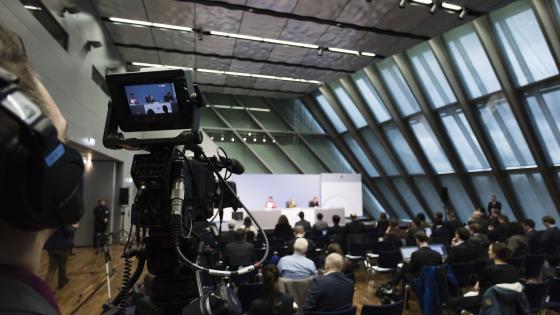“Too little, too late”, or “wait and see” are phrases that the media frequently use when observing the tendency for central banks to postpone and/or delay interest rate decisions. The recent behaviour of the Federal Reserve System (Fed) is paradigmatic.
In the aftermath of the severest recession since WWII, the Fed faces extraordinary challenges in designing and implementing monetary policy. The overall result has been massive monetary accommodation with interest rates close to zero, coupled with an exceptional expansion of the Fed's balance sheet. The Great Recession ended in June 2009, but seven years on, the Fed is still delaying the process of returning to normal. Expansionary monetary policy has been implemented long after the recession ended, raising questions over the drivers and consequences of monetary inertia – in this case, reluctance to leave the ultra-expansionary monetary status quo to start a policy of interest rate normalisation.
But the discussion over the (delayed) lift-off in US monetary policy is just the latest episode in a long-lasting debate, namely, how can inertia in monetary policy be explained? In several cases over the last two decades, central banks have shown reluctance to leave the monetary status quo, raising questions over the rationale that can justify such a stance. As has been insightfully pointed out (Orphanides 2015), at least in the case of US monetary policy, a period of monetary inertia after the end of a recession is not uncommon. At the same time, cases of monetary inertia have been registered for some time after the end of an expansion; further, this inertial feature of central bank behaviour has been especially noted in the case of the Fed, but it has also characterised many other central banks (Goodhart 1996, 1998, Woodford 1999, 2003). The bias towards the status quo has been recently highlighted focusing on the Bank of England’s Monetary Policy Committee (Barwell 2016).
So far, the economic literature has offered two different explanations: information inertia and governance inertia.
Originally, monetary inertia was explained by the observation that central bank decisions depend on information on the state of the economy, as well as on the recognition of the long and variable lags in the transmission of monetary policy. Monetary inertia can therefore be considered a rational strategy to avoid tough ‘stop-and-go’ policies and their consequences in terms of negative macroeconomic spillovers, and the tendency of central banks to adjust interest rates only gradually in response to changes in economic conditions can thus be considered optimal (Woodford 1999, Driffil and Rotondi 2007, Consolo and Favero 2009). More recently, optimal monetary policy has been derived by departing from the rational expectations hypothesis, i.e. by assuming that individual agents follow adaptive learning (Mohnar and Santoro 2014).
Under a different perspective, the case of monetary policy inertia has been analysed by exploring the role of central bank governance. Two studies focusing on Monetary Policy Committees (MPCs) seem particularly interesting, namely, Dal Bo (2006) and Riboni and Ruge-Murcia (2010).
Dal Bo (2006) shows that a voting procedure that requires a supermajority (i.e. ‘consensus setting’) leads the monetary policy committee (MPC) to behave as a conservative central banker à la Rogoff (1985). The supermajority rule mitigates issues of time-inconsistency and introduces a status quo bias in monetary policy decisions.
Riboni and Ruge-Murcia (2010) analyse four different frameworks in central banking governance: the simple majority (median voter) model, the consensus model, the agenda-setting model (where the chairman controls the board agenda), and the dictator model (the case of and influential chairman).
While the simple majority model and the dictator model are observationally equivalent to a one-man central bank, the consensus model and the agenda-setting model are different, creating something like a persistent status quo monetary policy. In the first two models, the MPC adjusts the interest rate taking into account the value preferred by the key members – the median voter and the chairman, respectively – regardless of the initial status quo. In the other two models, the MPC can keep the interest rate unchanged in the ‘inaction region’, i.e. monetary inertia can occur. Further, the agenda-setting model predicts larger interest rate increases than the consensus model when the chairman is more hawkish than the median member. In other words, inertia in interest rate decisions can be associated with features of central bank governance (governance inertia).
But now, what happens if we assume that psychological drivers can influence the decisions of the central bankers? In a recent paper, my co-author Carlo Favaretto and I simulated a monetary policy setting with three different kinds of central bankers (Favaretto and Masciandaro 2016).
The members of an MPC (i.e. central bankers) can be split into three groups – doves, pigeons, and hawks – depending on their monetary conservativeness. In the monetary policy literature, a specific jargon has been coined: a “dove” is a policymaker who likes to implement active monetary policies, including inflationary ones, while a “hawk” is a policymaker who dislikes them (Chappell et al. 1993, Jung 2013, Jung and Kiss 2012, Jung and Latsos 2014, Eijjfinger et al. 2013a, 2013b, Neuenkirch and Neumeier 2013, Wilson 2014, Eijffinger et al. 2015); “pigeons” fall in the middle. Throughout time, the dovish/hawkish attitude has become one of the main focuses of the analysis of monetary policy board decisions.
The model introduces sequentially the assumptions that each central banker is a high-ranking bureaucrat – i.e. a career-concerned agent – with his/her conservativeness, that a monetary policy committee formulates monetary policy decisions by voting with a simple majority rule, and finally that loss aversion characterises the behaviour of the central bankers – i.e. for every monetary policy choice, losses loom larger than gains, and both are evaluated with respect to the status quo.
The framework shows that, given the three types of central bankers, the introduction of loss aversion in individual behaviour influences the monetary policy stance under three different, but convergent, points of view. First of all, a moderation effect can emerge, i.e. the number of pigeons increases. At the same time, a hysteresis effect can also become relevant: both doves and hawks soften their stances. Finally, a smoothing effect tends to stabilise the number of pigeons. The three effects consistently trigger greater interest rate inertia, which is independent of both the existence of frictions and the absence or presence of certain features of central bank governance.
Loss aversion can explain delays and lags in changing the monetary policy stance, including the fear of lift-off after a recession. Needless to say, the behavioural motivation doesn’t rule out the other motivations already stressed in the literature.
The results shed light on the fact that central bankers are individuals who are subject to the same sources of behavioural bias that all individuals face. In the presence of behavioural bias, the outcome of different information sets and/or governance rules can be quite different with respect to the standard case.
In other words, central bankers can justify their lack of active choices using informational reasons (“we adopted a data-dependent strategy”) or governance drivers (“we need to reach a larger consensus”), but being both bureaucrats – i.e. career concerned players – and humans, other perspectives need to be explored, namely, that central bankers can act consistently with behavioural biases. This perspective also deserves attention when designing and implementing central bank governance rules.
In fact, governance rules are defined assuming the existence of a principal agent framework between citizens and central bankers as bureaucrats, where the bureaucrats are rational players. Therefore, the governance challenge is to design rules of the game that can produce optimal interest alignment between society and central bankers. But the less central bankers represent rational individuals in the traditional meaning, the more the design of governance procedures must take into account the possibility of behavioural bias. In other words, the simple assumption that central bankers are career-motivated players who care about prestige is not sufficient when behavioural biases – such as loss aversion – can emerge systematically. In calculating benefits and losses of different monetary policies, behavioural central bankers make choices that are quite different with respect to standard central bankers.
It is worth noting that loss aversion is just one source of behavioural bias. A cognitive psychology perspective can be usefully employed in understanding the intertemporal challenges embedded in monetary policy analysis.
References
Barwell, R (2016), “No Hawks, No Doves, Only Consensus: How Central Banks Set Interest Rate”, VoxEU.org, 19 December.
Chappell Jr, H W, T M Havrilesky and R R McGregor (1993), “Partisan Monetary Policies: Presidential Influence Through the Power of Appointment”, The Quarterly Journal of Economics, 108(1), 185-218.
Consolo, A and C FAVERO (2009), “Monetary Policy Inertia: More a Fiction than a Fact?”, Journal of Monetary Economics, 56(6), 900-906.
Dal Bo, E (2006), “Committees with Super Majority Voting yield Commitment with Flexibility”, Journal of Public Economics, 90(4), 573-599.
Driffil, J and Z Rotondi (2007), “Inertia in Taylor Rules”, CEPR DP No. 6570.
Eijffinger, Eijffinger, S, R Mahieu and L Raes (2013a), “Inferring Hawks and Doves from Voting Records”, CEPR DP No. 9418.
Eijffinger, Eijffinger, S, R Mahieu and L Raes (2013b), “Estimating the Preferences of Central Bankers: An Analysis of four Voting Records”, CEPR DP No. 9602.
Favaretto, F and D Masciandaro (2016), “Doves, Hawks and Pigeons: Behavioral Monetary Policy and Interest Rate Inertia”, Baffi Carefin Working Paper Series, n.21, Bocconi University.
Goodhart, C A E (1996), “Why Do the Monetary Authorities Smooth Interest Rates?”, LSE Financial Market Group Special Paper No. 81.
Goodhart, C A E (1998), “Central Bankers and Uncertainty”, LSE Financial Market Group Special Paper No. 106.
Jung A. and G Kiss (2012), “Voting by Monetary Policy Committees: Evidence from the CEE Inflation Targeting Countries”, MNB Working Paper No. 2.
Jung, A and S Latsos (2014), “Do Federal Reserve Bank President Have a Regional Bias?” ECB Working Paper No. 1731.
Neuenkirch, M and F Neumeier (2013), “Party Affiliation Rather than Former Occupation: The Background of Central Bank Governors and its Effect on Monetary Policy”, MAGKS Discussion Paper Series in Economics, n.36.
Orphanides, A (2015), “Fear of Lift-off: Uncertainty, Rules, and Discretion in Monetary Policy Normalization”, Federal Reserve Bank of St. Louis Review, Third Quarter, 173-196.
Riboni, A and F J Ruge-Murcia (2010), “Monetary Policy by Committee: Consensus, Chairman Dominance, or Simple Majority?”, Quarterly Journal of Economics, 125(1), 363-416.
Molnar, K and S Santoro (2014), “Optimal Monetary Policy when Agents are Learning”, European Economic Review, 66, 39-62.
Wilson, L (2014), “A Dove to Hawk Ranking of the Martin to Yellen Federal Reserves”, Department of Finance, University of Lousiana at Lafayette, mimeo.
Woodford, M (1999), “Optimal Monetary Policy Inertia”, NBER Working Paper No. 7261.
Woodford, M (2003), “Optimal Interest Rate Smoothing”, Review of Economic Studies, 70, 861-886.



